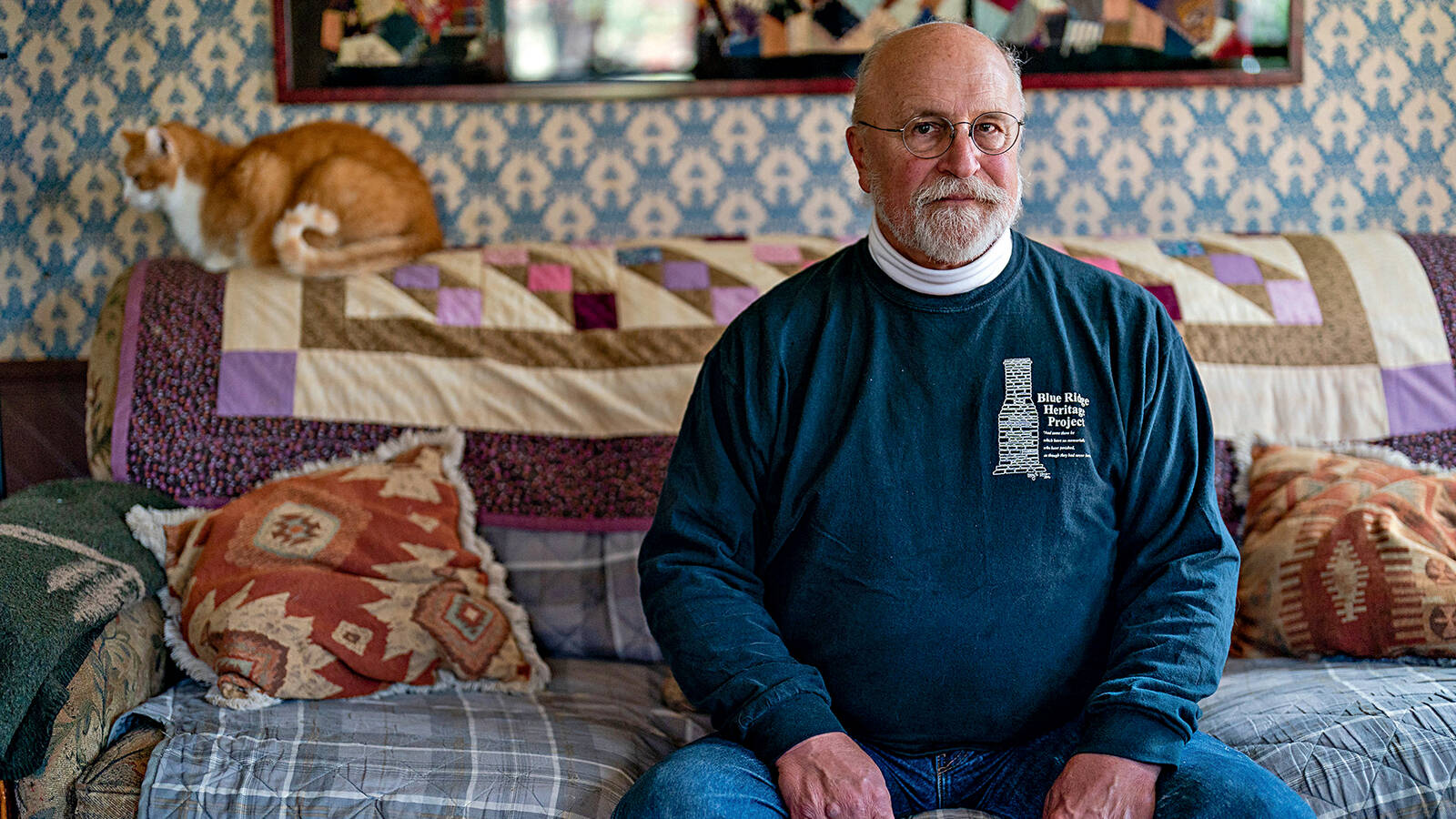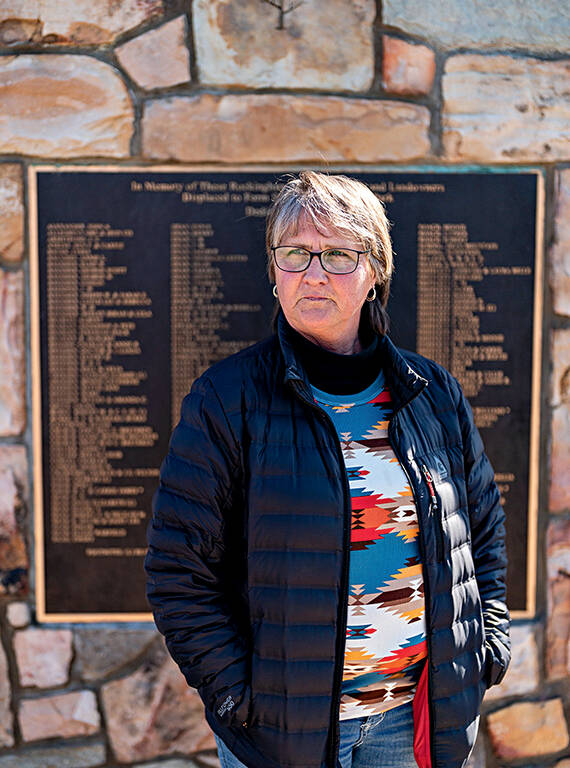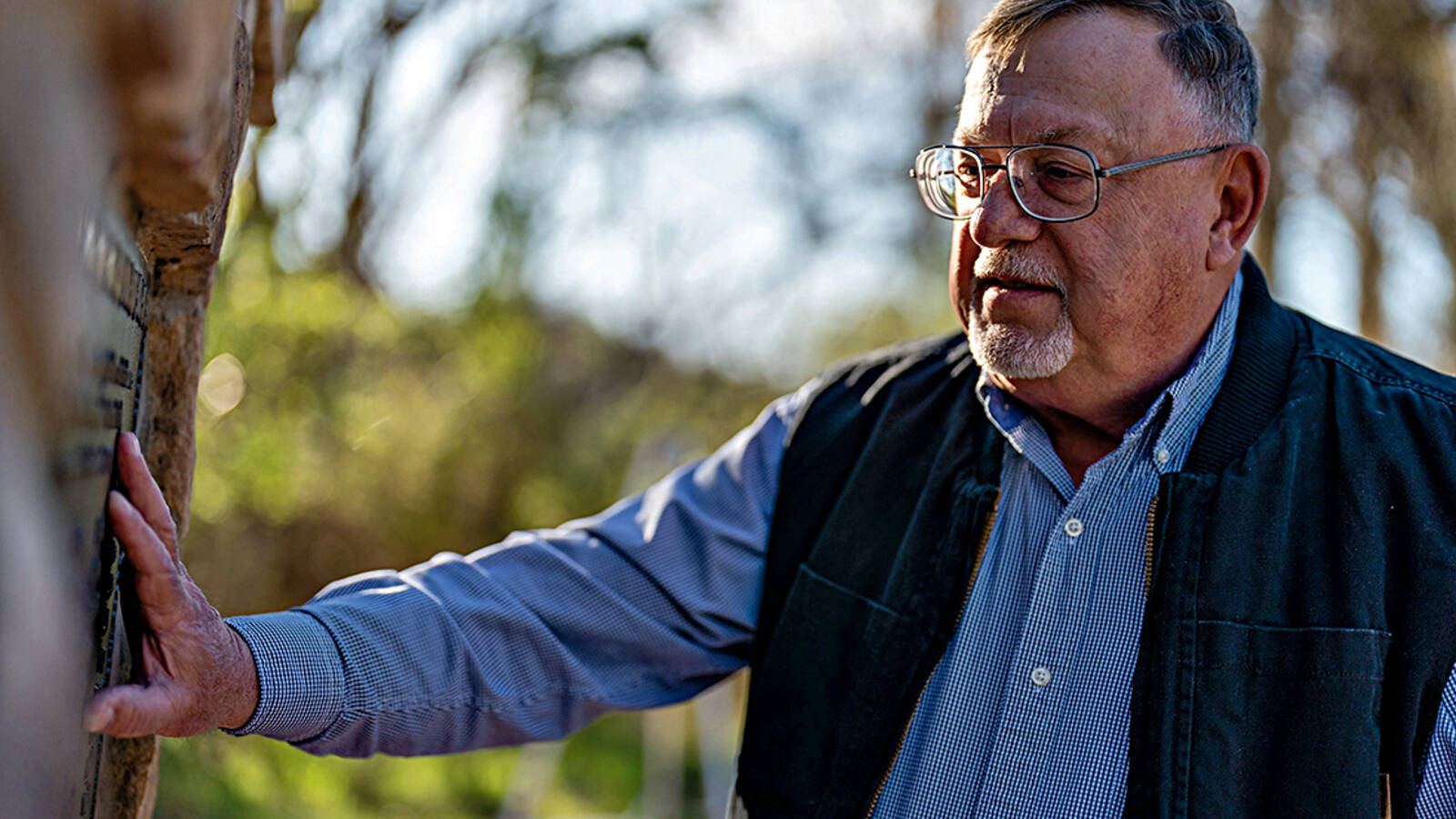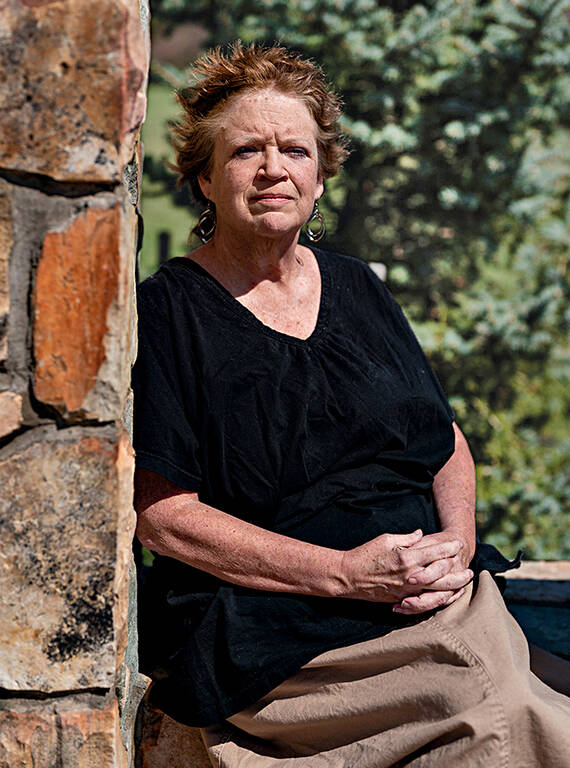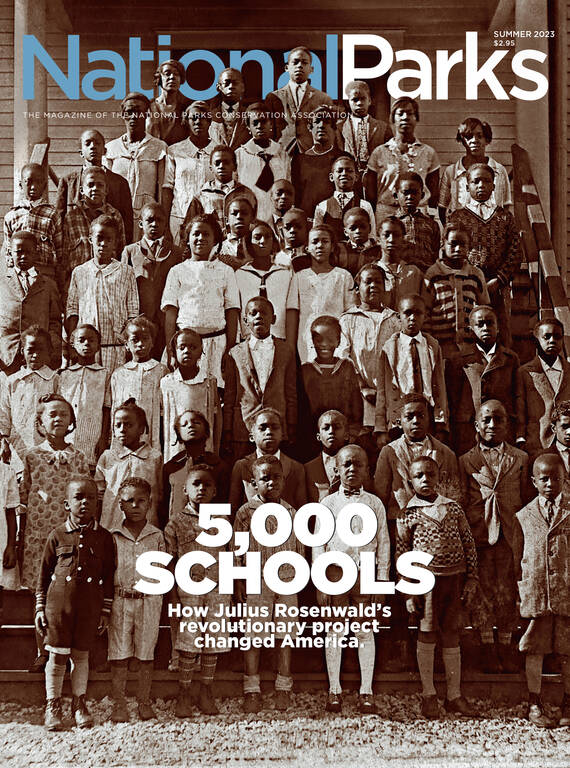Summer 2023
A Monumental Effort
Almost a century after Virginia pushed out mountain people to make way for Shenandoah National Park, monuments to honor their memory are helping their descendants heal.
This past March on a cold wet morning, 72-year-old Bill Henry stood next to a small lawn backed against a forested hillside. Along with wire-rimmed John Lennon glasses and a tiny diamond earring, the bearded and ponytailed retired high school teacher wore a practical fleece vest and jeans. His big boots could cover a lot of ground and, in many ways, they had. A journey that began 30 years earlier during Henry’s hikes in Shenandoah National Park was now nearing an end here in Augusta County at the park’s southern tip.
“Eleven years ago, I had an idea,” Henry told the couple of dozen people assembled at Grand Caverns Regional Park, just outside the national park. His idea was to honor the stories of the mountain people who once lived in Shenandoah. Despite having no experience in organizing or activism, Henry had pitched his concept to community meetings and civic groups and built a network of allies among local officials and park staff. He’d reached out to descendants after devoting years to getting to know them and their history. Along the way, the group created the Blue Ridge Heritage Project and settled on a plan to build eight monuments, each located in a county that had given up land for the park.
Every year, 1.5 million people visit Shenandoah, hiking its forested trails or taking in Skyline Drive’s majestic vistas, but the story of the park’s creation, like those of many others across the National Park System, is a painful one. The Native American people who called these mountains home for thousands of years were decimated or forced out by disease, warfare and broken treaties. And in the 1930s before the 200,000-acre park was created, the commonwealth of Virginia displaced perhaps thousands who had settled in the Blue Ridge Mountains — a move that still causes a lot of hurt today.
That day in March brought the groundbreaking for the eighth and final monument. One of the people by Henry’s side was Carrie Eheart, whose great-grandparents had lost the mountain community they’d depended on — a community she herself had only recently discovered.
“We don’t want those stories to be lost,” Henry said.
Bill Henry in his home in Stanardsville, Virginia. Henry is not related to the people who were displaced, but he took up the cause of memorializing them as his own.
“Bill is now an honorary descendant of the mountain people,” said Lisa Custalow, who has worked closely with Henry on the effort to build the monuments.
Carrie Eheart, shown here at the Rockingham County memorial, only discovered her family’s mountain past a few years ago. Her grandmother Louise Wood Austin grew up in Sugar Hollow in Albemarle County. As a girl, she probably didn’t know how to read — or swim. In the one story she told, she was drowning in a swimming hole when a young man jumped in to save her. They fell in love. Her father let them marry, and Austin’s new husband, a writer, took her to Waynesboro, where he taught her to read and write and where she later sold shoes in a department store. She was a very proper woman who always wore dresses. And she never said a word to Eheart about Sugar Hollow. “I just wish I could ask her, ‘What did you do there besides practically drown your future husband?’” Eheart said.
©ERIC LEEDarryl G. Merchant near the Warren County monument in Front Royal. His grandmother Goldie Nicholson always told wistful stories about family life as tenant farmers up in Warren County’s Nicholson Hollow. That bucolic lifestyle came to an abrupt end when her family was removed to a resettlement camp. Living there wasn’t free, and the terms for a new homestead shifted over time. Families often wound up moving yet again, Nicholson’s included. Merchant’s great-great-grandfather H. Edgar Merchant was no luckier, though he’d owned 90 acres up on Dickey Ridge. His compensation check was only enough to pay off the mortgage, and he lost the bees that had provided him with a living. That side of the family never talked about it. Merchant only stumbled across the story at the park’s Byrd visitor center.
©ERIC LEELisa Custalow, pictured here at the Rockingham County memorial, is still conflicted about the park’s creation. “My heart breaks for what the families have had to go through,” she said. “And yet the views up there — it’s a beautiful park, and it’s for everybody, and it has benefited so many people.”
Her mother, Etolia Shifflett, was born on Hightop Mountain in Rockingham County in 1933. The family was pushed out soon after. Many displaced families never talked about their mountain heritage due to negative stereotypes about “hillbillies.” Though the relocation was a painful subject, Custalow did once ask her mother how their family left, knowing some people went quietly while others resisted. “I wanted to hear, ‘Grandma was out on the porch with a shotgun,’” Custalow recalled. “But my mother said, ‘They told us we had to leave, and we left. You can’t fight the government.’ That wasn’t what I wanted to hear. But that was the feeling then, for most people.”
©ERIC LEEThe push for a scenic park that would protect the region’s ecosystems began in the early 1900s. Virginia businessmen, seeing an opportunity to boost the local economy, pitched the mountains overlooking the Shenandoah Valley. They described their proposed park as “pristine and uninhabited.”
It wasn’t. As park promoters well knew, large swaths had been cleared and farmed for generations: Roads crisscrossed the mountains, connecting homes, mills, churches and schools nestled in the hollows. “They wanted to see Virginia establish tourism as an industry instead of resource extraction,” said Claire Comer, an interpretive specialist at Shenandoah. As one park planner said at the time, “Scenery will be Virginia’s next cash crop.”
When Congress authorized Shenandoah (along with another national park in the Great Smoky Mountains) in 1926, some major challenges lay ahead. Shenandoah park promoters and state planners now had to acquire the land and donate it to the federal government — without any humans living on it. At last, it dawned on them this would not be easy.
I began to realize part of the healing process would have to include enabling the descendants to tell their own stories.
The proposed park overlaid roughly 1,000 small tracts, and many landowners and renters were in the way. By 1928, the Virginia General Assembly resorted to passing the Public Park Condemnation Act to speed things along. Landowners were compensated, but the law allowed officials to take control of all reluctant sellers’ properties by eminent domain using blanket condemnation.
It was still slow going. Disorganization and confusion at the official level led to the spread of conflicting information about whether the mountain people would have to leave. Eviction notices ultimately arrived in 1934. The new park was dedicated two years later.
Many of the mountain people had no political or economic power. Most went quietly. Empty houses were dismantled or sometimes burned, only the chimneys left standing.
As the decades passed, the forests grew back, hiding even the lonely stone chimneys from view.
Autumn-time in the 1950s and ’60s, the Henry family would pile in the car to go leaf peeping in Shenandoah. They’d drive from Northern Virginia a couple of hours down to Skyline Drive, pull over for a picnic and take in the sweeping views across the valley.
In the ’70s after college at Virginia Tech, Bill Henry knew two things: He loved hiking in the mountains, and he did not want to go back to Washington’s increasingly crowded suburbs. Once he got his teaching certificate, he took out a map of Virginia, looked at all the mountain counties and started applying for teaching positions.
He ended up in the Charlottesville area, where on a clear day he could see the mountains up in the national park. He kept moving closer until 1985 when he found the house in Greene County where he still lives, so close to Shenandoah that on one of his hikes in the park his route took him down the mountain and into his own backyard.
On another hike, Henry made a life-altering discovery. “One day, I was following an old roadbed, not anywhere near a trail,” he recalled. “And I came across a chimney, a stone chimney that was standing back in the forest. And it was like, wow. All these questions came to my mind. Like, what happened to these people that lived here?”
As a little girl in Charlottesville, Lisa Berry Custalow knew her family came from the mountains. She could tell it was a painful topic because whenever she asked about it, her mother would get teary-eyed, even though she’d been just a baby when her family left the mountains. Sensing so much sadness, Custalow would change the subject.
In 1994, Custalow was in her mid-20s and still curious. She went up to Shenandoah’s Byrd Visitor Center one day where she peered at the old display and watched a video describing the park as Virginia’s gift to America. The families who hadn’t willingly gifted their mountain homes were not part of the story the park told. Custalow felt like her family’s experience had simply been x-ed out.
Back home, she furiously described to her mother what she’d seen. She insisted it needed to be discussed. In public. Her mother was a woman of few words. “She just said, ‘If you do this, Lisa, you’re going to hurt a lot of people. You’re going to open up old wounds,’” Custalow recalled.
She did it anyway. Looking back, she said, “One of the challenges that I still have to deal with is, you can’t change the past or what happened. But you can be honest about what happened and channel that anger into positive action to move forward.”
Custalow posted flyers announcing public meetings for a group she called the Children of Shenandoah. Attendance soared after she added speakers, including Carolyn and Jack Reeder, who’d written several books about the park’s history.
“It was the first time for people to talk about what happened to their families in a public venue,” Custalow said. Older people spoke about looking back and seeing their houses burn from a distance. They and their descendants described being slandered with negative “hillbilly” stereotypes in the media and in person even though public records contained heart-wrenching letters these supposedly illiterate people had written to government officials, pleading to remain on their land. “There was so much pent-up emotion. Even today some people are just now discovering they’re descendants because their families never talked about it. So those were extremely angry sessions.”
Henry was among the attendees almost from the beginning. Just curious about the park’s history, he felt like an intrusive outsider at first because he was one of the few without a family connection to the park. “Back then we felt like it was us versus the world,” Custalow said. But over time, they came to accept the man they called “the hiker,” and Henry tried to listen through the emotion of their voices to understand why they were so upset.
“I felt a slow empathy coming on,” Henry said. “In time you think, ‘Well, how would I feel if they came and took my house and farm and then disregarded me?’”
She just said, ‘If you do this, Lisa, you’re going to hurt a lot of people. You’re going to open up old wounds.’
As the ’90s wore on, the Children of Shenandoah shifted from sharing their stories with each other to telling the wider world. They met with park officials, who by then were a receptive audience. A cultural resource specialist had begun conducting new research and collecting more oral histories, and one of the park’s own employees, Comer, was intimately familiar with their story.
Comer’s family lived in the valley but owned land south of Big Meadows for summer grazing. A house up there was home to a tenant farmer. When Virginia took the land for the park, Comer’s family was compensated, but the tenant farmer was not.
“Ownership has nothing to do with your sense of place, your heritage and your love of the land,” Comer said. “It isn’t that these people felt the land belonged to them and was taken from them. It’s that they felt they belonged to the land.”
Comer wound up helping develop an exhibit that would properly tell the story of the park’s creation. Custalow was pleased with the result. “They did a great job telling the story the way it really was,” she said. “That was all we wanted.” Still, Comer felt something was missing. “I began to realize part of the healing process would have to include enabling the descendants to tell their own stories.”
They Were Here First
Henry retired in 2009, and his days were suddenly wide open. He started volunteering on the local tourism council. The director there told Henry about meeting an elderly woman who’d been displaced by the park, the sadness still welling up in her eyes, and he wondered what he could do. Henry wondered that, too.
At a meeting with the park superintendent a few years later, people began throwing out ideas about how to keep expanding Shenandoah’s relationship with surrounding communities. “My hand went up,” Henry said. “And there I was, sharing my idea for a monument. I’d never talked about it publicly before.”
Soon, a few people joined him, and they incorporated the Blue Ridge Heritage Project as a nonprofit. Consensus came quickly on what the monument would look like: a stone chimney, with a plaque listing the names of the families who’d been displaced. Interpretive panels would tell their stories in words and photographs. Where to put the monument required more discussion. Inside the park might have seemed the obvious place. But Comer pointed out that if the monument was outside the park, the mountain people’s stories could be told from their perspective without interference. “It can’t be the National Park Service’s monument,” she said.
Eventually, the group settled on building not one but eight memorials — one in each of the counties where people lost land and homes to the park. Madison County was first: Descendants planned and erected the monument in the tiny crossroad of Criglersville. At the dedication in November 2015, so many people turned out that a sheriff’s deputy had to direct traffic. A man pointed out his family’s name on the plaque to his little girl. Older people who’d been children when they were displaced cried on the bench in front of the chimney.
“You could see the healing that was starting to happen,” said Custalow.
Darryl G. Merchant, a land surveyor, was at the Madison dedication as well. Tall and stocky with a white goatee and an easy smile, he’s descended from both landowners and residents. “It was a cross between a funeral and a picnic,” he recalled. “The chimney is like a tombstone for the families.”
The Albemarle and Greene county monuments were dedicated in 2016 and 2017. Then in 2018, the Warren County memorial was completed, built in part from stones Merchant gathered from hollows in the area.
“I just wanted to do something for my grandparents,” said Merchant, who spent years tracking down the surnames of the 68 families that were inscribed on the monument’s plaque. His grandmother Goldie Nicholson never forgave the government for taking away her family’s way of life, a resentment she passed on to Merchant in his youth. His grandfather Doley Nicholson, on the other hand, helped build the stone walls along Skyline Drive during his time with the Civilian Conservation Corps. He saw opportunity in his family’s eviction and went on to work as a Navy contractor for 40 years.
“The more I research it, I am becoming more like my grandfather,” Merchant said. “I’m grateful for Shenandoah National Park. Skyline Drive is a monument to our people.”
By 2018, seven of the eight monuments had been built. The final county, Augusta, was the least populated when the park was created. Augusta was the last to form a committee and the last to get a descendant on board. Carrie Eheart was that descendant, but she didn’t know she was one until 2016 when she was in her fifties. “My grandmother grew up in Sugar Hollow, but she never spoke of it,” Eheart said.

National Parks
You can read this and other stories about history, nature, culture, art, conservation, travel, science and more in National Parks magazine. Your tax-deductible membership donation of $25 or more entitles…
See more ›Tan and fit-looking, Eheart has an energetic voice that carries and an outdoorswoman’s wardrobe. She’d met Henry through a hiker friend. Coincidentally, around that time she and her brothers uncovered their family’s mountain past with help from a local historian. The pandemic slowed the Augusta County committee’s progress, but later this year, artisan Clyde Jenkins will begin laying stone for a 22-foot monument modeled on the chimney in his own home, a log cabin his grandfather built.
In the other counties, the monuments are already serving as touchstones for displaced families and offering teachable moments for visitors, while schoolteachers bring children for lessons in local history. The chimneys are also inspiring gatherings to celebrate mountain culture, including music, folk dance and artisanal crafts. “We’re moving forward,” said Custalow. “Having the family name on the chimney, it’s like a badge of honor now. That heritage isn’t something to be ashamed of anymore.”
The Mountain Museum opened in a clapboard building next to Madison County’s monument in Criglersville. And the counties’ tourism directors are collaborating on a driving tour app that will direct visitors to places that formed the foundations of the mountain people’s lives. It will also include Merchant’s map of all eight county monuments. “Bill Henry has been really good at bringing the separate parties together,” Merchant said. “He was very patient with us. We never had a systematic way of looking at our situation before and documenting our history.” With a laugh, he said, “Bill Henry’s a damn Yankee, but he’s our damn Yankee.”
ABOUT THE PHOTOGRAPHER
At the groundbreaking in Grand Caverns park, Eheart laid out a gallery of her brother’s drawings of the old family homeplace and shared the stories she’d learned about her great-grandfather Joe Wood, a storyteller nicknamed the Mayor of Sugar Hollow, who organized social gatherings and work parties to butcher hogs and haul chestnut planks. “It was a hard life but a good life,” Eheart told the assembled group.
When all the history-sharing and speechifying was done, Eheart and her fellow committee members picked up shovels alongside Henry and the local tourism director. Together they turned over the first spadefuls of dirt.
